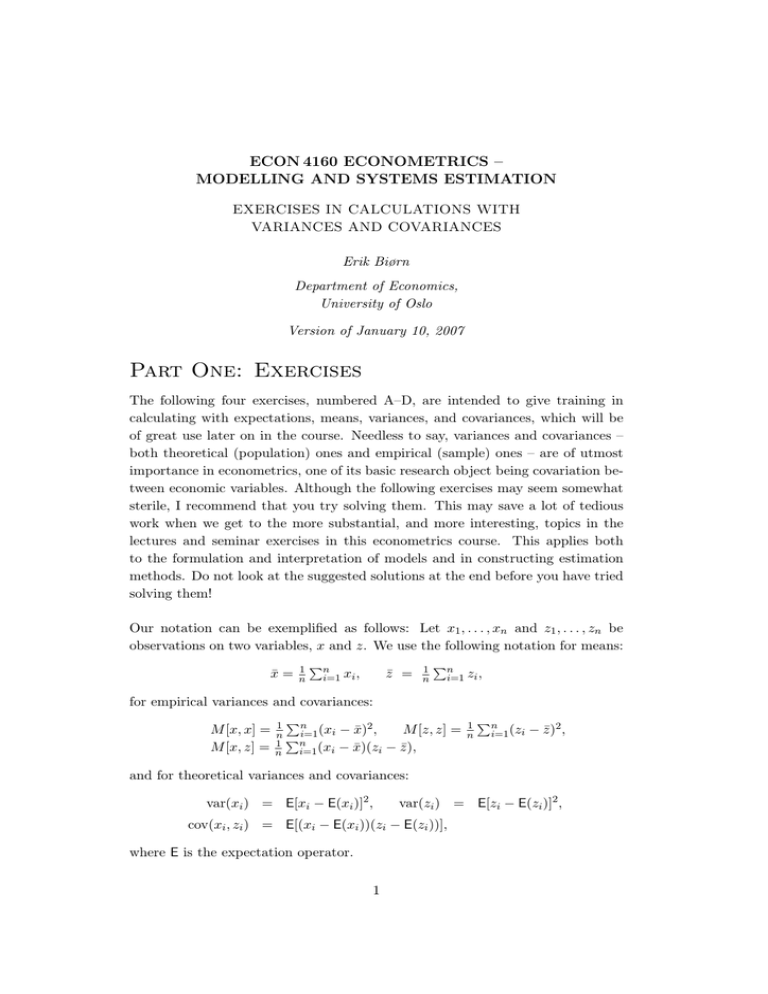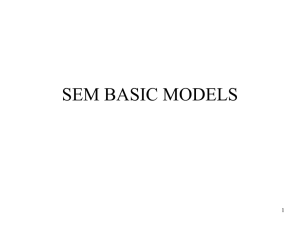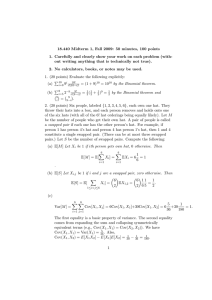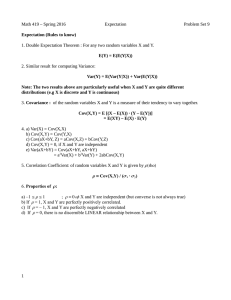Part One: Exercises ECON 4160 ECONOMETRICS – MODELLING AND SYSTEMS ESTIMATION
advertisement

ECON 4160 ECONOMETRICS – MODELLING AND SYSTEMS ESTIMATION EXERCISES IN CALCULATIONS WITH VARIANCES AND COVARIANCES Erik Biørn Department of Economics, University of Oslo Version of January 10, 2007 Part One: Exercises The following four exercises, numbered A–D, are intended to give training in calculating with expectations, means, variances, and covariances, which will be of great use later on in the course. Needless to say, variances and covariances – both theoretical (population) ones and empirical (sample) ones – are of utmost importance in econometrics, one of its basic research object being covariation between economic variables. Although the following exercises may seem somewhat sterile, I recommend that you try solving them. This may save a lot of tedious work when we get to the more substantial, and more interesting, topics in the lectures and seminar exercises in this econometrics course. This applies both to the formulation and interpretation of models and in constructing estimation methods. Do not look at the suggested solutions at the end before you have tried solving them! Our notation can be exemplified as follows: Let x1 , . . . , xn and z1 , . . . , zn be observations on two variables, x and z. We use the following notation for means: x̄ = 1 n Pn i=1 xi , z̄ = 1 n Pn i=1 zi , for empirical variances and covariances: M [x, x] = M [x, z] = 1 Pn 2 n P i=1 (xi − x̄) , n 1 i=1 (xi − x̄)(zi n M [z, z] = − z̄), 1 n Pn i=1 (zi − z̄)2 , and for theoretical variances and covariances: var(xi ) = E[xi − E(xi )]2 , var(zi ) = E[zi − E(zi )]2 , cov(xi , zi ) = E[(xi − E(xi ))(zi − E(zi ))], where E is the expectation operator. 1 Exercise A Given the equations (1) (2) yi = α + β xi + γ zi , wi = δ + ε xi + η zi , i = 1, . . . , n, i = 1, . . . , n, where yi , wi , xi and zi are considered as stochastic variables and α, β, γ, δ, ε and η as constants. Prove, by using the definitions of theoretical variances and covariances, that (1) imply the following relationships between theoretical variances and covariances: (a) (b) (c) var(yi ) = β 2 var(xi ) + 2βγ cov(xi , zi ) + γ 2 var(zi ), cov(yi , xi ) = β var(xi ) + γ cov(zi , xi ), cov(yi , zi ) = β cov(xi , zi ) + γ var(zi ). Further, show, by using (1) and (2), that the theoretical covariance between yi and wi can be expressed in terms of var(xi ), var(zi ) and cov(xi , zi ) as follows: (d) cov(yi , wi ) = β ε var(xi ) + (β η + γ ε) cov(xi , zi ) + γ η var(zi ). Note that (d) is a generalization of (a). Exercise B Similar relationships as in exercise A also hold for empirical variances and covariances. In this exercise you are invited to show this. Given the equations (1) (2) yi = α + β xi + γ zi , wi = δ + ε xi + η zi , i = 1, . . . , n, i = 1, . . . , n, where yi , wi , xi , zi can be considered either as stochastic or as non-stochastic variables and α, β, γ, δ, ε and η as constants. Prove, by using the definitions of empirical variances and covariances, that (1) imply the following relationships between empirical variances and covariances: (a) (b) (c) M [y, y] = β 2 M [x, x] + 2βγ M [x, z] + γ 2 M [z, z], M [y, x] = β M [x, x] + γ M [z, x], M [y, z] = β M [x, z] + γ M [z, z]. Further, show, by using (1) and (2), that the empirical covariance between y and w can be expressed in terms of M [x, x], M [z, z] and M [x, z] as follows: (d) M [y, w] = β ε M [x, x] + (β η + γ ε) M [x, z] + γ η M [z, z]. Note that (d) is formally a generalization of (a). 2 Exercise C Assume that x1 , . . . , xn and z1 , . . . , zn are non-stochastic and that u1 , . . . , un and v1 , . . . , vn are stochastic variables with the following properties: (1) (2) E(ui ) = E(vi ) = 0, ( E(ui uj ) = ( (3) E(vi vj ) = ( (4) E(ui vj ) = i = 1, . . . , n, σu2 , 0 for j = i, for j = 6 i, i, j = 1, . . . , n, σv2 , 0 for j = i, for j = 6 i, i, j = 1, . . . , n, σuv , 0 for j = i, for j = 6 i, i, j = 1, . . . , n. Explain why the empirical covariances M [x, u], M [x, v], M [z, u] and M [z, v] then will be stochastic variables. Show that the definitions of theoretical variances and covariances imply: (a) var(M [x, u]) = (b) var(M [z, u]) = (c) cov(M [x, u], M [z, u]) = (d) cov(M [x, v], M [z, v]) = (e) cov(M [x, u], M [x, v]) = (f ) cov(M [z, u], M [z, v]) = (g) cov(M [x, u], M [z, v]) = σu2 σv2 n M [x, x], var(M [x, v]) = n M [x, x], σu2 σv2 M [z, z], var(M [z, v]) = n n M [z, z], 2 σu n M [x, z], σv2 n M [x, z], σuv M [x, x], n σuv M [z, z], n cov(M [x, v], M [z, u]) = σnuv M [x, z]. 3 Exercise D This exercise generalizes the problems in exercises A and B. Given the equations (1) yi = a + (2) wi = d + PK k=1 bk xki , i = 1, . . . , n, k=1 ek xki , i = 1, . . . , n, PK where yi , wi , and xki are considered as n values of K + 2 stochastic variables and a, bk , d, ek as 2K + 2 constants. Prove, by using the definitions of theoretical variances and covariances, that (1) and (2) imply: (a) (b) cov(yi , xri ) = (c) cov(yi , wi ) = Let PK var(yi ) = x̄k = 1 n PK 2 k=1 bk var(xki ) + k=1 bk cov(xki , xri ), PK PK k=1 bk ek var(xki ) + k=1 PK r=1,r6=k bk br cov(xki , xri ), r = 1, . . . , K, PK k=1 PK r=1,r6=k bk er cov(xki , xri ). Pn i=1 xki , M [xk , xr ] = M [y, xr ] = 1 n 1 n Pn i=1 (xki Pn i=1 (yi − x̄k )(xri − x̄r ), − x̄)(xri − x̄r ), k, r = 1, . . . , K, and show, by using the definitions of empirical variances and covariances, that also the following relationships hold: (d) M [y, y] = (e) M [y, xr ] = (f ) M [y, w] = PK PK k=1 r=1 bk br M [xk , xr ], PK r = 1, . . . , K, k=1 bk M [xk , xr ], PK PK k=1 r=1 bk er M [xk , xr ]. Here (c) generalizes (a) and (f ) generalizes (d). 4 Part Two: Solutions Solution to exercise A Taking expectations through (1) and (2) it follows that (3) (4) E(yi ) = α + β E(xi ) + γ E(zi ), E(wi ) = δ + ε E(xi ) + η E(zi ), i = 1, . . . , n, i = 1, . . . , n. Ad (a). By (i) deducting (3) from (1), (ii) squaring the expression obtained on both sides of the equality sign, (iii) taking expectation of the squared expression, and (iv) using the definition of theoretical variances and covariances, (a) follows. This formula also follows from the general formula for calculating the theoretical variance of an arbitrary linear combination of stochastic variables. Ad (b). By (i) deducting (3) from (1), (ii) multiplying the expression obtained by (xi − E(xi )) on both sides of the equality sign,, (iii) taking expectation of the product obtained, and (iv) using the definition of theoretical covariances, (b) follows. Ad (c). Shown in a similar way as (b). Ad (d). By (i) deducting (3) from (1) and (4) from (2), (ii) multiplying the two expressions obtained, (iii) taking expectation of the product obtained, and og (iv) using the definition of theoretical variances and covariances (d) follow. Solution to exercise B Taking means across the n observations in (1) and (2) it follows that (3) ȳ = α + β x̄ + γ z̄, (4) w̄ = δ + ε x̄ + η z̄. Ad (a). By (i) deducting (3) from (1), (ii) squaring the expression obtained on both sides of the equality sign, (iii) taking mean across the n observations of the squared expression, and (iv) using the definition of empirical variances and covariances, (a) follows. This formula also follows from the general formula for calculating the empirical variance of am arbitrary linear combination of variables. Ad (b). By (i) deducting (3) from (1), (ii) multiplying the expression obtained by (xi − x̄) on both sides of the equality sign,, (iii) taking means across the n observations of the product obtained, and (iv) using the definition of empirical covariances, (b) follows. Ad (c). Shown in a similar way as (b). 5 Ad (d). By (i) deducting (3) from (1) and (4) from (2), (ii) multiplying the two expressions obtained, (iii) taking mean across the n observations of the product obtained, and (iv) using the definition of empirical variances and covariances (d) follow. Solution to exercise C It here suffices to demonstrate (a), (c) and (g). The others follow by analogy. Ad (a). By definition, we have (5) M [x, u] = 1 n Pn i=1 (xi − x̄)(ui − ū) = 1 n Pn i=1 (xi − x̄)ui , P since ni=1 (xi − x̄) = 0 hold identically. Using the formula for the variance of a linear function of stochastic variables – recall that the x’s are considered as non-stochastic – we get var(M [x, u]) = (6) = P 1 var ( ni=1 (xi n2 2 σu n2 Pn i=1 (xi − x̄)ui ) = 1 n2 Pn i=1 (xi − x̄)2 var(ui ) σ2 − x̄)2 = nu M [x, x]. Here the second equality follows from the fact that u1 , . . . , un are uncorrelated [cf. (2)], the third equality from the fact that they have the same variance, σu2 [cf. (2)], and the fourth equality from the definition of M [x, x]. The second parts of (a) and (b) can be shown in a similar way. Ad (c). By definition, we have (7) since M [z, u] = Pn i=1 (zi 1 n Pn i=1 (zi − z̄)(ui − ū) = 1 n Pn i=1 (zi − z̄)ui , − z̄) = 0 holds identically. From (1), (5) and (7) it follows that (8) E(M [x, u]) = E(M [z, u]) = 0. Consequently, we have (9) cov(M [x, u], M [z, u]) = E(M [x, u]M [z, u]) = = = = 1 E n2 h P n i=1 (xi − x̄)ui ) ( h ³P n j=1 (zj Pn Pn 1 E j=1 (xi − x̄)ui (zj i=1 n2 P n 1 2 i=1 (xi − x̄)(zi − z̄)E(ui ) n2 σu2 Pn i=1 (xi − x̄)(zi − z̄) = 2 n 6 ´i − z̄)uj i − z̄)uj σu2 n M [x, z]. Here, the fourth equality follows from the fact that u1 , . . . , un are uncorrelated [cf. (2)] (so that the double sum after the third equality sign degenerates to a simple sum). The fifth equality follows from the fact that u1 , . . . , un have the same variance, σu2 , [cf. (2)] and the sixth equality from the definition of M [x, z]. In a similar way (d) can be proved. Ad (g). By definition, we have (10) M [z, v] = 1 n Pn i=1 (zi − z̄)(vi − v̄) = 1 n Pn i=1 (zi − z̄)vi , which implies that E(M [z, v]) = 0. From (5) and (10) it follows that (11) cov(M [x, u], M [z, v]) = E(M [x, u]M [z, v]) = = = = 1 E n2 h P n ( i=1 (xi h − x̄)ui ) ³P n j=1 (zj ´i − z̄)vj i Pn Pn 1 E i=1 j=1 (xi − x̄)ui (zj − z̄)vj n2 P n 1 i=1 (xi − x̄)(zi − z̄)E(ui vi ) n2 P σuv n (x − x̄)(z − z̄) = σuv M [x, z]. i i=1 i 2 n n Here the fourth equality follows from the fact that ui and vj are uncorrelated for all j 6= i [cf. (4)] (so that the double sum after the third equality sign degenerates to a simple sum). The fifth equality follows from the fact that ui and vi have the same covariance, σuv , for all i [cf. (4)], and the sixth equality from the definition of M [x, z]. The second equality in (g) can be shown in a similar way. In this way we have also demonstrated that (e) and (f ) hold, as they are formally special cases of (g). 7 Solution to exercise D It suffices to demonstrate (b), (c), (e) and (f ), since (a) formally is a special case of (c) and (d) is a special case of (f ). Taking expectation through (1) and (2) it follows that (3) E(yi ) = a + (4) E(wi ) = d + PK k=1 bk E(xki ), i = 1, . . . , n, k=1 ek E(xki ), i = 1, . . . , n. PK Taking means across the n observations in (1) and (2) it follows that (5) ȳ = a + (6) w̄ = d + PK k=1 bk x̄k , k=1 ek x̄k . PK Ad (b). By (i) deducting (3) from (1), (ii) multiplying the expression obtained by (xri − E(xri )), (iii) taking expectation on both sides of the equality sign in the product obtained and (iv) using the definition of theoretical covariances (b) follows. Ad (c). By (i) deducting (3) from (1) and (4) from (2), (ii) multiplying the two expressions obtained, (iii) taking expectation on both sides of the equality sign in the product obtained, and (iv) using the definition of theoretical variances and covariances (c) follows. Ad (e). By (i) deducting (5) from (1), (ii) multiplying the expression obtained by (xri − x̄r ), (iii) taking means across the n observations on both sides of the equality sign in the product obtained and (iv) using the definition of empirical covariances (e) follows. Ad (f ). By (i) deducting (5) from (1) and (6) from (2), (ii) multiplying the two expressions obtained, (iii) taking means across the n observations on both sides of the equality sign in the product obtained, and (iv) using the definition of empirical variances and covariances (f ) follows. 8








